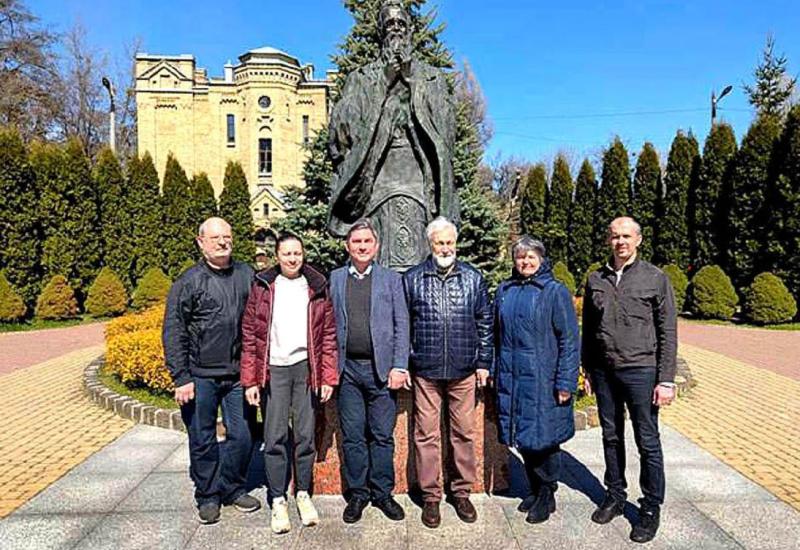In response to the current challenges and demands of Ukrainian society, as well as to ensure Ukraine's competitiveness in the world, promote the development of national research potential, and integrate into the global research space, the Ministry of Education and Science holds competitions among scientists, followed by the provision of funding for advanced fundamental research that involves setting and solving pressing scientific problems. Kyiv Polytechnic continues to acquaint readers with the projects of our university's scientists that have received state funding this year. Among them is a project developed by researchers at the E.O. Paton Electric Welding Institute.
📰
The development of aircraft engine manufacturing is linked to solving problems such as increasing the service life and efficiency of gas turbine engines. These problems are solved using surface engineering methods, namely gas thermal spraying of wear- and erosion-resistant, heat-resistant, and thermal barrier coatings, as well as various methods of surface strengthening by modifying it, optimizing the composition of powders, and improving the design of parts operating in high-temperature conditions.
The great interest of the international industrial community in the widespread use of gas thermal spraying technologies is evidenced by the creation of professional associations in technically developed countries. In the US, it's the International Thermal Spray Association (ITSA), which works with the American Welding Society (AWS); in Germany, it's the Association of Thermal Sprayers (GTS), which works with the German Welding Society (DVS); and in Japan, it's the Japan Thermal Spray Society (ITSS). These associations offer engineers, researchers, and students interested in coating issues news about the gas thermal spraying industry, information about companies, events, and products. Thanks to their activities, scientists and engineers exchange experience, new standards are developed, and advanced methods for the production and testing of thermal spray coatings are disseminated.
Special attention is paid to the sealing of turbomachinery, which is also solved by the use of thermal spray technology. Sealing of turbomachines is an important area of application for gas thermal spraying. The use of special sealing coatings significantly reduces energy losses and increases engine efficiency, which is critical for the aviation industry.
At the 6th International Conference “The Future of Gas Turbine Technology” in Brussels in 2012, an original presentation was given on “Thermally sprayed abradable coating technology for sealing in gas turbines.” It was shown that the use of gas thermal spraying technologies has revolutionized the technology of sealing turbomachines, as it has become possible to ensure an individual approach to the creation of powders for gas thermal spraying of abrasive sealing coatings, with the possibility of spraying them to a specified hardness range with a high level of microstructural control.
When creating sealing coatings in the turbine housing, difficulties arise due to high-temperature operating conditions and the aggressiveness of fuel combustion products. The balance between erosion resistance and abrasion resistance of coatings requires finding optimal solutions that combine high wear resistance of materials with sufficient plasticity to minimize mechanical damage during operation. Erosion resistance and abrasion resistance are determined by the strength properties of materials and are inversely proportional values, therefore, the creation of effective sealing coatings that are resistant to abrasion is one of the most difficult and urgent tasks in aviation materials science.
At the E.O. Paton Educational and Scientific Institute of Materials Science and Welding Paton, a group of teachers, scientists, graduate students, and students has been conducting research in the field of creating gas-thermal coatings using plasma generators (plasmatrons) with composite powders, including nanoscale powders, for more than twenty years.
Over 100 scientific papers have been published, patents have been obtained, and monographs have been written, which can be found in the Scientific and Technical Library of Igor Sikorsky Kyiv Polytechnic Institute.
It is thanks to continuous work in this area that the research group of the Department of Welding Production, in collaboration with scientists from the Department of High-Temperature Materials and Powder Metallurgy of the E.O. Paton Electric Welding Institute and the Department of Electronic Devices and Systems of the FEL, was able to win the competitive selection of fundamental and applied scientific research of the Ministry of Education and Science of Ukraine, where hundreds of projects were considered. This victory confirms the relevance of this research for the development of the aviation industry.
The main team of researchers includes Professor A. Kuzmichev of the Department of Electronic Devices and Systems, winner of the Boris Paton Prize for his work “Physical and technical principles of creating controlled nano- and microstructures on the surface of solids”; young scientist of the Department of High-Temperature Materials and Powder Metallurgy S. Teslya, who has scientific grants funded by national competitive selections, and others.
The departments where the scientists involved in the project work have all the necessary modern equipment for gas-thermal (plasma) coating, creation of modified composite powders with nanoscale components, modern laboratories for microstructural research and mechanical testing.
Students studying at the E.O. Paton Institute of Welding Technology have every opportunity to acquire practical skills in working with this equipment and, if they wish, can obtain a PhD or Doctor of Technical Sciences degree.
I would like to express my gratitude to the staff of the Research Department of Igor Sikorsky KPI. Their constant support, coordination, and assistance with scientific projects at the university will contribute to the development and promotion of Ukrainian science in the international community. I would also like to thank the staff of the Department of Scientific and Innovative Support of the Educational Process for their help in preparing and submitting patent applications for the invention.

